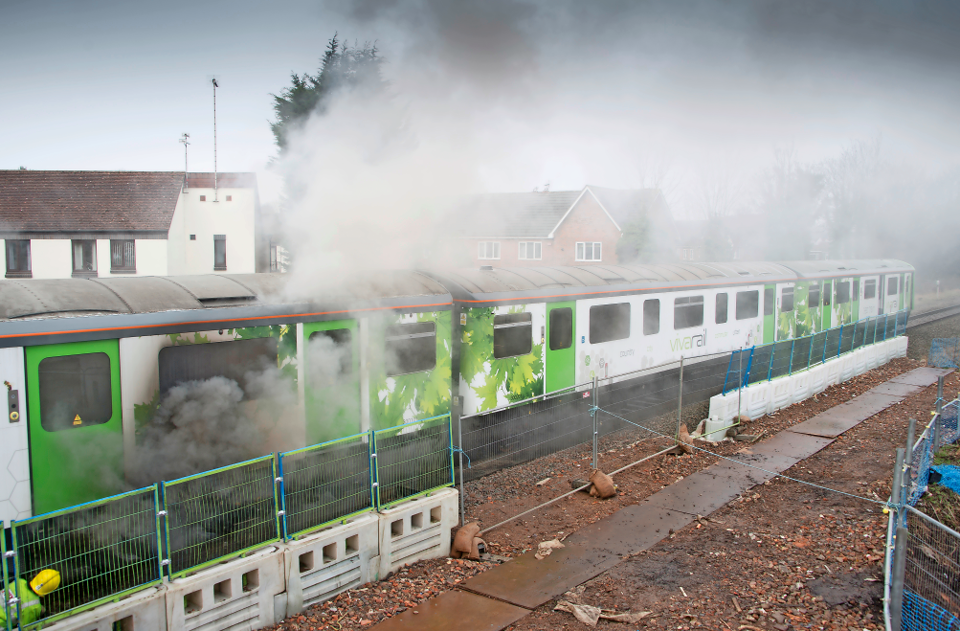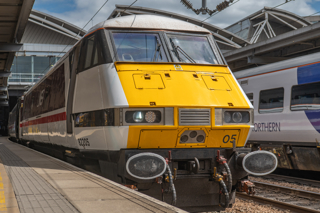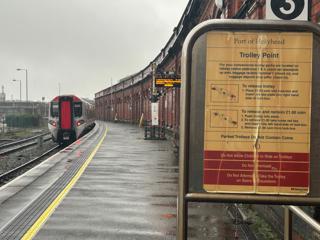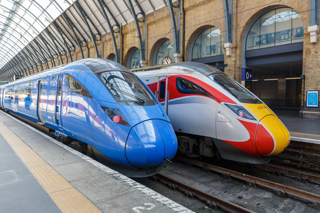2017 could hardly have started on a sourer note for Vivarail Chairman Adrian Shooter, following the aborted test run of his company’s prototype Class 230 D-Train on December 30 2016.
A fire that broke out within one of the four ‘genset’ diesel-powered engine modules, located beneath the three-car test unit, not only spelled the premature end of the train’s journey between Coventry and Nuneaton that day, but also its entry into service. The plug was subsequently pulled on an eight-month trial with London Midland that had been scheduled to begin in February.
With the goal of achieving safety certification now forlorn, the stricken D-Train was left to limp back from the incident site at Kenilworth to an engineer’s siding in Coventry, before its removal by road to Long Marston, where Shooter promptly launched an internal investigation to determine the cause.
As RAIL reported in February, an oil leak was eventually identified as the culprit, after a forensic inspection of the charred remains of the destroyed ‘genset’. Vivarail was able to point the finger of blame at mistakes made by an external supplier.
But not one to rest on his laurels, Shooter quickly set about repairing 230001 while also implementing a full series of design improvements recommended by the investigation report, aimed at mitigating the risks of any repeat catastrophe (see panel, page 49).
He now says the modified D-Train will be ready to resume main line testing on the Cotswold Line in May. Providing safety certification is then granted, the public will be given a first opportunity to ride it on June 21-22, when the prototype is scheduled to shuttle visitors from Honeybourne to the Rail Live exhibition being held at Long Marston (see feature, pages 42-45).
RAIL was invited back to check on progress at Vivarail on March 30, when an upbeat Shooter pointed to the several positive factors to emerge from the incident - not least the safe evacuation of all personnel aboard the D-Train, and the lack of damage inflicted to the internal saloon space directly above the burning unit.
Dismissing any suggestion of Vivarail suffering the ‘January blues’, he tells RAIL: “My view has always been that there is no cloud without a silver lining, and with this we demonstrated that the fire protection within the car body was very good. We’ve learned from it, and we now know that we have a really good vehicle that can stand up to it. The train has now been repaired and re-liveried, and we’ve been right through the engine module to rectify all the issues.
“Our customers have all said ‘we appreciate it was a demo vehicle and we applaud your transparency’, following the report we did. We also shouldn’t forget that this has happened to other people, but we just happened to be in the public gaze. I seem to remember a Class 172 catching fire at Warwick Parkway in September 2015, but that wasn’t nearly as widely reported.”
Seemingly undeterred by the blaze at Kenilworth, Shooter is firmly pushing ahead with Vivarail’s mission to convert its 220 withdrawn ex-London Underground D78 vehicles to heavy-rail use, by activating its next phase.
That is because the D-Train is designed to be a modular train, and eventually available in a wide range of power sources.
230001 is a diesel electric multiple unit (DEMU) that uses two detachable diesel engines beneath each driving car to power its electric traction motors. But these diesel engines are detachable, to enable easy maintenance but also to enable their replacement with batteries or a combination of both. Alternatively, the D-Train is designed so it can run as an EMU either on third rail or an overhead supply, with a minimal change of the base design.
This would give operators the option to run D-Trains on either electrified or non-electrified lines, by using diesel engines, electrically powered traction motors, on-board batteries or a hybrid configuration.
Before this can happen, Vivarail technicians are currently working on a battery-powered demonstrator vehicle, to prove to potential customers that the concept works and to refine the technology. The demonstrator vehicle must also achieve EMC (electromagnetic compatibility) approval before a battery-powered version of the D-Train can be certified for main line use.
Vivarail Design Director Neil Bates explains: “This gives us lots of flexibility for whatever scenarios an operator is looking at. I guess if we had a strap line it would be ‘show me’, so we have built a single-car battery-powered unit to confirm our calculations for running on different types of batteries.
“We want to show two things: that a pure battery train can run on short branch lines while recharging at a terminus station, and that a battery/EMU hybrid could charge up and then run beyond the wires, which could be relevant on some routes where Network Rail is distinctly unenthusiastic about electrification. There’s also another advantage that a route could be partially electrified, to avoid the cost where bridges might need raising or track needs lowering.
“Between now and July, we will run this demonstrator in a variety of ways to assess its range, acceleration, braking and lots of other performance characteristics. In July, we will then replace the original DC traction motors with new AC traction motors, so we can complete EMC testing.”
The battery-powered demonstrator is a little more utilitarian than 230001, which has been fully fitted out with accessible toilets, information screens, CCTV, LED lighting and a variety of seating configurations to demonstrate both the modular choices available to customers and its compliance with 2020 PRM-TSI (Persons of Reduced Mobility - Technical Specifications for Interoperability) regulations.
The demonstrator has not been refurbished or deep cleaned yet, and so still resembles its former life as a driving car on London Underground’s District Line with all its original interior fittings still intact. It also has three engine modules rather than the two that will be carried by the finished production version, which will be available to customers either as a two-car or three-car unit with driving cars at either end. That’s because a diesel engine has been retained on the demonstrator to simulate the electrical supply needed to test it as an EMU/battery hybrid, on Long Marston’s unelectrified test track.
The diesel engine is also powering the air compressor which is needed for the brakes, and which will eventually be replaced by an electric compressor. The battery modules are also charged for the time being by the extra diesel engine, although that too will be reconfigured to take its charge from a mains supply.
This leaves two battery modules, one beneath the train and one within the saloon.
The battery-powered D-Train variant does not yet have a class number, unlike the Class 230 DEMU prototype, but will gain one once testing is complete and approvals have been granted during the summer.
“I haven’t got an answer yet for what class the battery train will be,” adds Shooter. “The rolling stock library will either specify that, or give us a choice when we finish testing.”
A technician with a laptop is on board the train, monitoring its performance and capturing key data on power consumption, how long the batteries take to recharge, and how much regenerative energy is being returned to the batteries from the vehicle’s braking system.
Shooter says all this information will be vital when speaking to customers, to enable more accurate business cases to be drawn up for deploying battery trains on specific routes. He adds that the technician is also keeping a close eye on acceleration rates, because it is so rapid when powering a single car around Long Marston’s 3km test track.
The single-car battery train using just two modules can apparently more than match the acceleration of the four-engine DEMU prototype, and so acceleration has had to be artificially limited so as not to exceed the test track’s 40mph speed limit, and to protect the underframe equipment.
Shooter says: “In the next few months we will be gathering data that we can apply to customers’ individual cases with conviction, and we’ve already had some customers on the train whose feedback has been generally very good. There has been a lot of interest in this as no one has previously had the opportunity to buy a battery train, but soon they will.”
Although Shooter is unable to provide details of firm orders, or of interested parties for any of the D-Train variants (for confidentiality reasons), there is already ample evidence that Vivarail is gearing up to begin full production of D-Trains later in the year.
RAIL is shown a new two-road strip-out shed where D-Stock vehicles will be prepared for conversion, while plans are at an advanced stage to build a tented area in the summer in front of Vivarail’s main four-road workshop, to accommodate up to nine cars. This is so the company can achieve an output of two finished two-car or three-car D-Trains per month by the turn of the year, with the first batch ready to enter traffic in January.
Before then, it is expected that the first production train will be completed in November as a DEMU, to join 230001 in traffic, while the battery train will have received electromagnetic compatibility approval by then to provide customers with the full range of options.
“We’ve been speaking to a lot of people about forthcoming franchises, which Department for Transport rules state I can’t talk about,” adds Shooter. “But we have people doing detailed design work to turn this place into a production facility, so we can start to build a fleet of these trains, to fulfil firm orders.”
Between now and then Vivarail will have to overcome one final hurdle, which is the more competitive marketplace to have emerged since the D-Train project began. With the pace of NR’s electrification works having slowed, and many projects such as the Midland Main Line now being placed on hold, stock cascades are being affected. More operators will now be reconsidering their options for new stock.
Without new overhead wires, one such bi-modal alternative option to the D-Train to have emerged recently is the Class 319 Flex train. Announced by rolling stock owning company Porterbrook in December (RAIL 818, 819), it would mean diesel-powered alternators being fitted beneath the driving cars of EMUs that are currently being sent off lease by Govia Thameslink Railway from its Thameslink services, providing a secondary power source.
Shooter feels that this merely reinforces the market’s need for D-Trains, and serves as a positive reminder of the strong appetite for hybrid trains running either as EMU/DMU or in EMU/battery configurations.
He also points to the relative advantages his product has over the ‘319s’, and concludes: “The ‘319’ is an interesting product - I’ve known it since specifying it in the 1980s , but it has its place. It doesn’t have the flexibility, power-to-weight ratio or the acceleration of the D-Train, and it’s more expensive to run as it will need more fuel.
“The D-Train can also run as a two-, three- or four-car unit or whatever, whereas the ‘319’ runs pretty much in a fixed formation. So I’d say the ‘319’ is the right train in some circumstances, and good luck to Porterbrook.
“The majority of people like the ‘crowd busting’ layout of the D-Train, too, and we can seat 44 in the saloon and another 100 standing. Dwell time is becoming more and more important, so having a train like ours is seen as very desirable. You can get 400 on a three-car D-Train, which is much more than a ‘319’ which has lots of 3+2 seats. And we can still do 30-second station stops.
“This is an emerging market, and there are opportunities out there, so this won’t be the last now that Network Rail has got into some difficulty with electrification.”
This feature was published in RAIL 825 on 22nd April 2017
















Login to comment
Comments
No comments have been made yet.